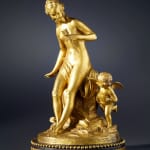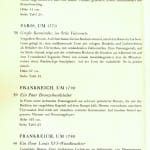Louis-Simon Boizot (after)
Further images
Literature
"Kunstwerke aus dem Besitz Baron Albert von Goldschmidt-Rothschild: Gemälde, Bronzen, Bijoux, Möbel, Porzellan, Tapisserien" from Schloss Grüneburg, Frankfurt, sold by Ball and Graupe, Berlin 9th-14th March 1933, lot 37, catalogued as 'Venus und Amor' by Etienne Maurice Falconet, (height: 41 cm) and pl. 24 of the sale catalogue, illustrating an almost identical gilt and patinated bronze statuette from the Baron Albert von Goldschmidt-Rothschild collection. Emile Bourgeois, "Le Biscuit de Sèvres au XVIIIe Siècle", 1909, vol. II, pl. 43, illustrating a Sèvres biscuit porcelain figurine of 1773 in the Musée de Sèvres, after the same model by Louis-Simon Boizot titled 'Nymphe Éprouvant avec Surprise les Traits de l'Amour' or 'Venus à la Flèche'. "Louis-Simon Boizot (1743-1809): Sculpteur du roi et directeur de l'atelier de sculpture à la manufacture de Sèvres", 2001, exhibition catalogue, p. 199, no. 57, featuring the same model.
An extremely fine and rare Louis XVI gilt bronze statuette with ebonised wooden base after a model by Louis-Simon Boizot known as 'Nymphe Éprouvant avec Surprise les Traits de l'Amour' or 'Venus à la Flèche' featuring the figure of a young and beautiful woman with her long hair gathered in a chignon and naked except for some drapery that wraps around her upper right thigh, half seated upon a rock while holding an arrow in her left hand as she gazes downward toward the youthful figure of a winged Cupid who, balancing on one foot, points toward her with his right hand, both figures on an oval rocky plinth set upon a stepped oval ebonised wooden base mounted with a gilt fluted band below a string of gilded pearls
Paris, date circa 1780-90
Height 36 cm.
An almost identical gilt bronze statuette supported on the same ebonised wooden base was once owned by Baron Albert von Goldschmidt-Rothschild (1879-1941), which was sold in 1933 along with many other magnificent works of art from his residence at Schloss Grüneburg. It is tempting to suggest that the present statuette was that same piece; however Baron Goldschmidt-Rothschild's work was supported on toupie feet, whereas the present work bares no evidence of it ever having had feet below the base (hence the slight difference in their height). Nevertheless, comparison with the illustration in the Goldschmidt-Rothschild sale catalogue shows that they were of the same quality and each would have sat comfortably beside the rest of his large and important collection. Among those pieces was a pair of Sèvres covered vases (now in the Metropolitan Museum, New York), a Louis XVI porcelain vase (now in the Detroit Institute of Art), exceedingly fine pieces of Louis XV and Louis XVI furniture, Old Master paintings and an array of other French eighteenth century gilt bronzes.
Although Baron Albert von Goldschmidt-Rothschild's statuette was described in the sale catalogue as being by or after Etienne Maurice Falconet (1716-1791), it is in fact after a model by Louis-Simon Boizot (1743-1809), who succeeded Falconet as the chief modeller at the Sèvres Porcelain Manufactory and worked in a very similar style to his predecessor. The present model was created by Boizot in 1773 and was known under two different titles namely 'Nymphe éprouvant avec surprise les traits de l'Amour' or 'Venus à la Flèche' but it was known under the former title when Boizot exhibited his original terracotta model of the subject at the Paris Salon of 1773, no. 238. Like many of Boizot's models, his Salon piece (which measured two 'pieds' in height) was then issued in biscuit or unglazed porcelain by Sèvres. Boizot subsequently resumed this composition in 1802, to create a life-size marble titled 'Venus et l'Amour'.
As noted many of Boizot's compositions bore a similarity to those by Falconet, of which the present example is no except, comparing for instance with Falconet's celebrated 'Baigneuse' (1762; Musée du Louvre) as well as his 'Galathée' from his Pygmalion group, in which the graceful elongated limbs, facial features and hairstyles of the elegant female figure all accord. While Boizot tended to favour softer modelling, the figure of Venus or nymph, like those by Falconet, has a sensuous quality though her demure pose and down cast eyes ensure an inherent delicacy.
Boizot inherited his artistic talent from his father Antoine Boizot (1704-82) who was a designer at the Gobelins. A pupil of René-Michel Slodtz, Boizot studied in Paris at the Académie Royale. In 1762 he won the Prix de Rome and then after a period at the Ecole Royale des Elèves Protégés he completed his education at the Académie de France in Rome. In 1771, the year after he had completed his studies, Boizot was accepted into the Académie but was not received as a full member until 1778. In addition to the Académie he also regularly exhibited at the Paris Salon up until 1800. During the earlier part of his career, Boizot was in great demand, receiving numerous commissions for decorative sculpture such as providing the model for the celebrated clock known as the 'Avignon' clock, cast in gilt bronze by Pierre Gouthière (circa 1770; Wallace Collection, London). Other works from this period include a set of marble and bronze caryatids for one of the chimneypieces at Château de Fontainebleau (1772; now Château de Versailles) as well as various works for Château de Louveciennes, where he worked for Madame du Barry. It was probably on her instigation that in 1773 Boizot was appointed artistic director of the sculpture studio at Sèvres. During his career at the royal porcelain factory, which continued up until 1800, he produced a series of more than 150 charming models that were reproduced in biscuit porcelain, in which the austerities of Neo-classicism were softened by a restrained Rococo element. In addition to small-scale intimate groups, he produced the models for numerous allegorical compositions as well as a surtout de table known as the 'Russian Parnassus' (1778; Musée de Sèvres), a toilet set for the comtesse du Nord (1782; Pavlovsk Palace) and the so called large 'Medici, vases (1783; Musée du Louvre).
The present model was created during Boizot's most fruitful period during the 1770s and 1780s, when amongst other pieces he produced a series of high quality portrait busts including marbles of Louis XVI (Paris Salon, 1777), Queen Marie-Antoinette (Paris Salon 1781) and the latter's brother Joseph II of Austria (1777; now at the Petit Trianon, Versailles). Less formal busts include that of his wife's uncle the celebrated marine and landscape painter Claude-Joseph Vernet (shown at the Salon of 1783, of which there is a later version from 1806 in the Musée du Louvre). Boizot was also commissioned by the Bâtiments du Roi to execute a marble statue of Jean Racine (1785-7; Musée du Louvre) as part of a series portraying illustrious Frenchmen; in addition he received a number of ecclesiastical commissions, counting among them a marble statue of Saint John the Baptist (1785) as well as a large plaster relief of the Baptism (1781), both for Saint Sulpice, Paris.
Professing Republican views during the French Revolution, Boizot played an important role in the Commission des Monuments, which advised on the preservation of artistic heritage. He continued to receive official commissions under the Consulate and Empire periods, including bronze reliefs for the Colonne de la Grande Armée at Place Vendôme, Paris, (1806-7), a statue of Militiades for the Senate in the Palais du Luxembourg, Paris, (c. 1806) though probably the most familiar was the Fontaine du Palmier, at Place du Châtelet, Paris which, erected in 1808, was to celebrate Napoleon Bonaparte's Egyptian Campaign.







